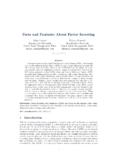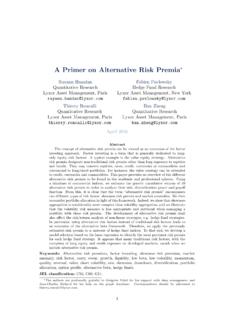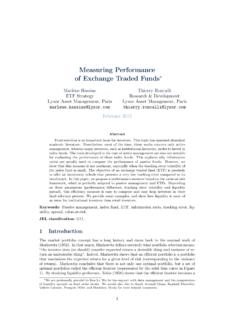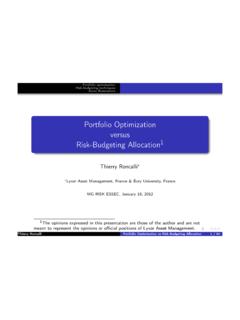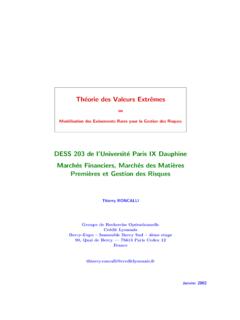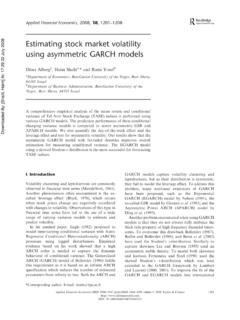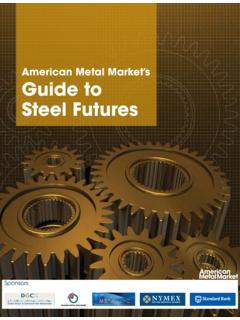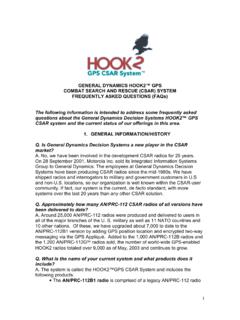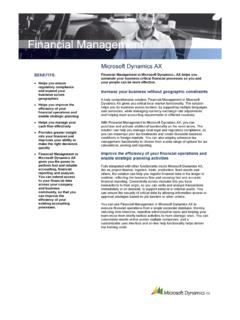Transcription of On the Market Portfolio for Multi-Asset Classes
1 On the Market Portfolio for Multi-Asset Classes Rodolphe LouisResearch & DevelopmentLyxor Asset Management, RoncalliResearch & DevelopmentLyxor Asset Management, 2012 AbstractThe influence of the CAPM theory on the financial theory of investment has in-creased with the development of passive management. Today, equity or fixed-incomemarket portfolios can easily be defined using equity and fixed-income indexes. Theseindexes also play an important role in active management as they serve as case of Multi-Asset Classes is more complex. Indeed, indexes taking into accountboth stocks and bonds do not exist today. However, most investors need such refer-ences as their principal problem is to define their stock/bond asset mix policy.
2 It isespecially true for institutional investors like pension funds and long-term investors. Inthis article, we show how to compute the Market Portfolio of equity and fixed-incomeinstruments. We then analyse the specificity of such a Portfolio according to coun-tries or regions and how this Portfolio has changed over the last thirty years. Thedynamics of the Market Portfolio also gives useful information about the evolution ofex-ante risk premia of stocks and bonds. Finally, we illustrate how the Market portfoliocould be used to benchmark diversified funds and to characterize the bets of long-terminvestment : Market Portfolio , stock, bond, benchmark, multi-assets allocation, active man-agement, risk premium, strategic asset allocation, long-term investment IntroductionThe concept of Market Portfolio has a long history and dates back to the seminal work ofMarkowitz (1952).
3 In this paper, Markowitz defines precisely whatportfolio selectionmeans: the investor does (or should) consider expected return a desirable thing and variance ofreturn an undesirable thing . Indeed, Markowitz shows that an efficient Portfolio is theportfolio that maximises the expected return for a given level of risk (corresponding to thevariance of return). Markowitz concludes that there isn t only one optimal Portfolio , but aset of optimal portfolios which is called the efficient studying the liquidity preference, Tobin (1958) shows that the efficient frontier be-comes a straight line in the presence of a risk-free asset.
4 In this case, optimal portfolios cor-respond to a combination of the risk-free asset and one particular efficient Portfolio named We thank Raphael Dieterlen and Guillaume Lasserre for their helpful the Market Portfolio for Multi-Asset Classesthe tangency Portfolio . Sharpe (1964) summarizes the results of Markowitz and Tobin asfollows: the process of investment choice can be broken down into two phases: first, thechoice of a unique optimum combination of risky assets1; and second, a separate choiceconcerning the allocation of funds between such a combination and a single riskless asset .This two-step procedure is today known as theSeparation Theorem(Lintner, 1965).
5 One of the difficulties to compute the tangency Portfolio is to precisely define the vectorof expected returns of the risky assets and the corresponding covariance matrix of 1964, Sharpe develops the CAPM theory and highlights the relationship between the riskpremium of the asset (the difference between the expected return and the risk-free rate)and its beta (the systematic risk with respect to the tangency Portfolio ). By assuming thatthe Market is at equilibrium, he shows that the prices of assets are such that the tangencyportfolio is the Market Portfolio , which is composed by all risky assets in proportion totheir Market capitalization.
6 The major contribution of Sharpe has led to an increasingdevelopment of empirical investigations. Early empirical studies like Blacket al.(1972) orFama and MacBeth (1973) generally accept the validity of the CAPM theory. But, withthe sophistication of econometric tests (Lewellen and Nagel, 2006) and the emergence ofconcurrent models (APT, Fama-French, etc.), the CAPM theory is today less accepted byacademics2and , two concepts introduced by the seminal work of Sharpe continue to be exten-sively used in the asset management industry: the beta and the Market Portfolio . This lastone has generated the fabulous development of indexes and passive management.
7 Investingin US or Euro equities is today facilitated by the existence of indexes like the S&P500 indexor the Eurostoxx index among others, whereas the same conclusion holds for fixed-incomeinstruments. The Market Portfolio has had also a major impact on the theory and prac-tice of investment management as explained by Dimson and Mussavian (1999): it is nowcommon to view a managed Portfolio as a blend of a passive Portfolio (such as index fund)and an active Portfolio comprising a series of bets on the relative performance of individualsecurities . This is particularly true for portfolios investing in one asset class like equities orbonds, but certainly not for portfolios investing in Multi-Asset Classes .
8 But as Roll (1977)points out, the Market Portfolio defined in the theoretical CAPM, is an index of multi-assetclasses including of course (domestic) equities, but also bonds, foreign assets, is also curious that investors refer to the Market Portfolio when they consider onespecific asset class, but do not use it when they analyze their entire Portfolio . This remarkis particularly obvious for diversified funds which are generally benchmarked to a constantmix Portfolio of an equity index and a fixed-income index. They express also their bets withrespect to this constant mix benchmark. This remark is also valid for long-term investorslike pension funds.
9 They also quantify their bets by comparing their tactical asset allocationto their strategic asset allocation policy, but they never analyze them with respect to themarket Portfolio . One may explain this paradox, because indexes of Multi-Asset Classes donot exist yet, certainly because index providers for equities are not the same than those forfixed-income instruments. But comprehensive data are available, especially since 10 years,and we could now build the Market Portfolio for Multi-Asset this article, we restrict our analysis to stock/bond asset Classes , because it is certainlythe main challenge that face long-term investors: how much capital must be invested re-spectively in equities and bonds?
10 In section 2, we show how to compute stock/bond market1It is precisely the tangency Merton (1973), Roll (1977), Breeden (1979) or Fama and French (1996).2On the Market Portfolio for Multi-Asset Classesportfolios and compare them with respect to countries and regions. Then, we estimate thebond and equity risk premia priced by the Market in Section 3. Section 4 is dedicated tothe use of the Market Portfolio for benchmarking diversified funds and for characterizing thebets of long-term investment policies. Section 5 finally Computing the Market Portfolio for Multi-Asset classesExcept the works of Roger Ibbotson (see for example Ibbotson and Fall, 1979 and Ibbotsonand Siegel, 1983), the literature on the computation of the global Market Portfolio is verylimited.
